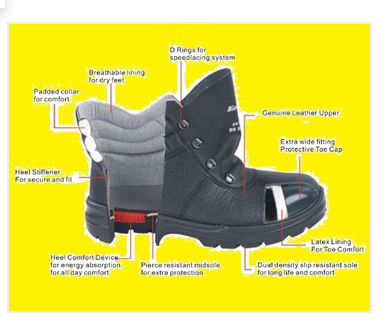
Many of us work in an environment where it’s important to make sure we have suitable footwear. Safety shoes can make a massive difference when it comes to remaining injury free in the workplace.
Often referred to as steel toe cap boots or rigger boots, safety boots and shoes come in a variety of styles and fittings depending on your requirements and what the needs are within your role. If you’re someone that does a lot of work outdoors on a construction site for example, a pair of safety boots with a solid, substantial sole is probably the wisest option as they will provide you with the best protection against the elements as well as any hazards. On the flip side, a pair of safety boots may not be needed if you work in a kitchen, here safety shoes with a slip-resistant sole are likely to serve you better.
Not only have safety boots served a practical purpose, but they have also had their moments in fashion too, particularly in the skinhead and punk subcultures where an industrial/military look is the one to go for.
Here we’re going to look at what makes a safety shoe and why, as well as the different types available and what you should look out for when buying safety footwear.
1) Toe Cap - Even though they’re often referred to as having steel toe caps, this isn’t necessarily the case. Sometimes the reinforced toe cap in safety boots and shoes can be made from composite materials, plastic such as TPU (thermoplastic polyurethane) or even aluminium.
As all safety boots are made for different uses, the minimum requirements from a toe cap vary from boot to boot. Regardless of this and the materials that they’re made from, any protective toe cap should withstand a minimum of 100 joules in a drop test.
2) Upper - Most safety footwear will have smooth or nubuck leather uppers as opposed to manmade materials. Some safety shoes are also made with textile or synthetic uppers such as micro-velour, these are quite significantly more breathable so work well in hot conditions, however leather is a much more stable material so offers greater protection against the elements and hazards.
3) Lining - As the lining is in direct contact with the foot, it’s important it is made from a material that allows breathability, absorbs moisture and dries quickly. Most linings in safety boots are made from materials such as cotton, wool or leather or thermoregulation textile composites as all of these have those qualities.
4) Insoles - The insole is designed to offer protection for the feet as well as comfort, with that in mind, most insoles in safety shoes are made from leather or a non-woven material such as wool. These materials are durable, absorb moisture efficiently and dry quickly, making them ideal for insoles.
5) Outsoles - The outsoles on safety boots are most commonly made from polyurethane, TPU or rubber. All of these materials have different characteristics, so it’s important to consider this when choosing the right safety footwear for you.
Some safety shoes may also have additional padding for support, heel caps and scuff caps. Whilst not present in every case, they should be considered, especially if you use your feet to operate heavy machinery.

Safety shoes are used for all manner of jobs that require foot protection. From kitchens to construction, warehousing and factory work, safety boots or shoes might be required. However different safety footwear is made to suit different conditions. All safety shoes are graded for compliancy to a certain criterion, depending on the type of conditions they’re created for. Most safety footwear can be identified easily with specific symbols that are often found on the sole. Below is a breakdown of the standard European symbols and classifications used to grade safety footwear:
|
Rating |
Safety Factor |
|
SB |
A toe cap capable of withstanding an impact up to 200 joules. This is the basic level for safety footwear. |
|
S1 |
A toe cap capable of withstanding an impact up to 200 joules as Well as a fully enclosed heel and anti-static properties within the sole. |
|
S2 |
A toe cap capable of withstanding an impact up to 200 joules as Well as a fully enclosed heel, anti-static properties and water resistant. |
|
S3 |
The same as S2 plus penetration resistance and a cleated sole. |
|
S4 |
200 joule toe cap protection and all rubber or polymeric outsole and upper with anti-static properties and energy absorbing insole. |
|
S5 |
The same as S4 plus penetration resistance and cleated outsole. |